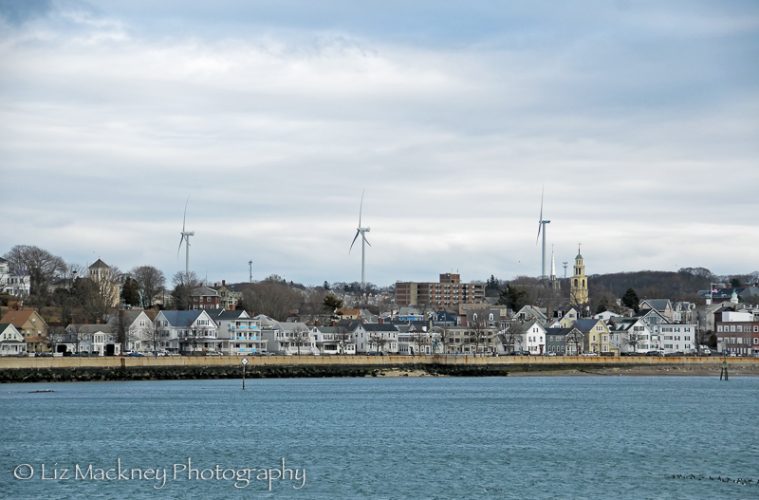The trio of wind turbines towers over Gloucester, their slowly spinning blades visible from miles away, sometimes slicing through low-hanging clouds. Erected in 2012, the machines already rank among the city’s most notable landmarks, but there is more to them than their striking appearance: Since they came online, they have saved the city $750,000 in energy costs.
Now, the turbines—alongside a host of other green initiatives—have earned Gloucester recognition as one of the leading clean energy communities in the state. Environment Massachusetts, a Boston-based advocacy organization, recently included Gloucester in a report highlighting cities and towns of Massachusetts that are leaders in the movement toward renewable energy.
“Gloucester is helping to show that when local leaders and concerned citizens work together, cities and towns can make major progress in addressing climate change and growing the local clean energy economy,” says Ben Hellerstein, state director of the group.
“Gloucester and the other communities we highlighted in the report are showing that cities and towns in Massachusetts are continuing to lead the way on clean energy. We hope state leaders will follow their example.”
As concern about warmer temperatures, extreme weather, and rising sea levels continues to mount, more and more communities, businesses, and individuals are looking for ways to reduce their use of the oil and gas that contribute to climate change. With clean energy technology improving and prices falling, a future of renewable energy seems increasingly within reach.
Massachusetts has long been one of the leaders in moving toward that future. Today, 11 percent of the state’s power comes from renewable sources and its solar capacity is 200 times what it was in 2006. And many—perhaps most—of the towns and cities across Massachusetts have made efforts to boost their use of clean energy and reduce their overall consumption.
A handful of these communities, however, stand out as green energy leaders, according to the Environment Massachusetts report. Gloucester is one of 17 noted for their achievements.
While Gloucester’s turbines may be the most visible contribution to the movement, the city’s other efforts to reduce consumption of fossil fuels are less obvious but equally important. The city recently established a municipal aggregation program, which will increase the portion of the town’s power supply coming from renewable sources and could mean lower electricity rates.
Gloucester’s six white electric cars can be spotted zipping around town on official business, and vehicle charging stations are available to the public at City Hall.
Using $690,000 of funding from the state’s Green Communities program, Gloucester has switched streetlights to LED bulbs and made municipal buildings more energy efficient by improving heating and air conditioning systems and upgrading interior lighting. These efforts save taxpayer money and set an example for area residents and businesses, Hellerstein says. Perhaps even more important, they have reduced carbon emissions by about 800 metric tons a year, the equivalent of taking 620 cars off the road.
“Even small changes can make a big difference in improving a building’s energy efficiency,” Hellerstein says. Residents are getting in on the act as well. Gloucester is also home to the Solar Challenge, an effort to get at least 100 homes or businesses to install private solar electricity systems. The goal was to achieve this level by 2017, but the number was actually reached within just seven months of the program’s launch in fall 2015, says Susan Hoague, the program’s solar coach. In fact, since the beginning of 2014, more than $9 million in private investment has gone into solar installations in the city.
The other communities recognized by Environment Massachusetts range from Cape Cod to the western end of the state. The report points to Holyoke’s use of solar and hydropower, Belchertown’s sharp reductions in energy use, Boston’s green building standards and energy reporting regulations, and New Bedford’s pursuit of offshore wind. On the Cape and Islands, a regional energy cooperative is pushing wind energy, installing solar panels on capped landfills, and investigating battery storage for renewably generated power.
There is, however, plenty more to be done. “To avoid the worst impacts of global warming, we need to move quickly toward 100 percent renewable energy,” Hellerstein says. Gloucester is ready to do its part. The organizers of the Solar Challenge are trying to rally yet more locals to go solar. The city still has plenty of potential for more installations, Hoague says, pointing to a study that estimates as many as 3,000 of the city’s homes are appropriately sited for solar panels. “There still is a lot Gloucester can do just with solar clean energy initiatives,” Hoague says.
In fact, Massachusetts has the resources to meet all of its energy needs with power from renewable sources, the Environment Massachusetts report concludes. Rooftop solar panels alone could provide nearly half of the needed electricity, according to a study from the National Renewable Energy Laboratory.
Why put in the effort to disturb the status quo?
Extreme weather events have increased more than 80 percent in the state in the past 70 years—consider the heavy snows of 2014 and 2015, or the record high temperatures of recent summers. Climate change could threaten many of New England’s traditional industries, like fishing, and cause rising sea levels that will eat away at the coastline. “Climate change,” Hoague observes, “is not waiting for us.”

